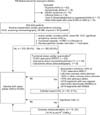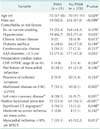1. Greenhalgh RM, Brown LC, Kwong GP, Powell JT, Thompson SG. EVAR trial participants. Comparison of endovascular aneurysm repair with open repair in patients with abdominal aortic aneurysm (EVAR trial 1), 30-day operative mortality results: randomised controlled trial. Lancet. 2004; 364:843–848.
2. Hertzer NR, Beven EG, Young JR, O'Hara PJ, Ruschhaupt WF 3rd, Graor RA, et al. Coronary artery disease in peripheral vascular patients. A classification of 1000 coronary angiograms and results of surgical management. Ann Surg. 1984; 199:223–233.
3. Kertai MD. Preoperative coronary revascularization in high-risk patients undergoing vascular surgery: a core review. Anesth Analg. 2008; 106:751–758.
4. McFalls EO, Ward HB, Moritz TE, Goldman S, Krupski WC, Littooy F, et al. Coronaryartery revascularization before elective major vascular surgery. N Engl J Med. 2004; 351:2795–2804.
5. Poldermans D, Schouten O, Vidakovic R, Bax JJ, Thomson IR, Hoeks SE, et al. A clinical randomized trial to evaluate the safety of a noninvasive approach in high-risk patients undergoing major vascular surgery: the DECREASE-V Pilot Study. J Am Coll Cardiol. 2007; 49:1763–1769.
6. Fleisher LA, Beckman JA, Brown KA, Calkins H, Chaikof EL, Fleischmann KE, et al. ACC/AHA 2007 guidelines on perioperative cardiovascular evaluation and care for noncardiac surgery: a report of the American College of Cardiology/American Heart Association Task Force on Practice Guidelines (Writing Committee to Revise the 2002 Guidelines on Perioperative Cardiovascular Evaluation for Noncardiac Surgery) developed in collaboration with the American Society of Echocardiography, American Society of Nuclear Cardiology, Heart Rhythm Society, Society of Cardiovascular Anesthesiologists, Society for Cardiovascular Angiography and Interventions, Society for Vascular Medicine and Biology, and Society for Vascular Surgery. J Am Coll Cardiol. 2007; 50:e159–e241.
7. Thygesen K, Alpert JS, Jaffe AS, Simoons ML, Chaitman BR, White HD, et al. Third universal definition of myocardial infarction. J Am Coll Cardiol. 2012; 60:1581–1598.
8. Islamoğlu F, Atay Y, Can L, Kara E, Ozbaran M, Yüksel M, et al. Diagnosis and treatment of concomitant aortic and coronary disease: a retrospective study and brief review. Tex Heart Inst J. 1999; 26:182–188.
9. Galland RB. Abdominal aortic aneurysms and concomitant coronary artery disease. Is routine dipyridamole thallium scintigraphy still justified? J Cardiovasc Surg (Torino). 2003; 44:417–422.
10. Kioka Y, Tanabe A, Kotani Y, Yamada N, Nakahama M, Ueda T, et al. Review of coronary artery disease in patients with infrarenal abdominal aortic aneurysm. Circ J. 2002; 66:1110–1112.
11. Sun T, Cheng YT, Zhang HJ, Chen SH, Zhang DH, Huang J, et al. Severe coronary artery disease in Chinese patients with abdominal aortic aneurysm: prevalence and impact on operative mortality. Chin Med J (Engl). 2012; 125:1030–1034.
12. Takahashi J, Okude J, Gohda T, Murakami T, Hatakeyama M, Sasaki S, et al. Coronary artery bypass surgery in patients with abdominal aortic aneurysm: detection and treatment of concomitant coronary artery disease. Ann Thorac Cardiovasc Surg. 2002; 8:213–219.
13. Prinssen M, Verhoeven EL, Buth J, Cuypers PW, van Sambeek MR, Balm R, et al. A randomized trial comparing conventional and endovascular repair of abdominal aortic aneurysms. N Engl J Med. 2004; 351:1607–1618.
14. Lederle FA, Freischlag JA, Kyriakides TC, Matsumura JS, Padberg FT Jr, Kohler TR, et al. Long-term comparison of endovascular and open repair of abdominal aortic aneurysm. N Engl J Med. 2012; 367:1988–1997.
15. Becquemin JP, Pillet JC, Lescalie F, Sapoval M, Goueffic Y, Lermusiaux P, et al. A randomized controlled trial of endovascular aneurysm repair versus open surgery for abdominal aortic aneurysms in low- to moderate-risk patients. J Vasc Surg. 2011; 53:1167–1173.e1.
16. Rinckenbach S, Hassani O, Thaveau F, Bensimon Y, Jacquot X, Tally SE, et al. Current outcome of elective open repair for infrarenal abdominal aortic aneurysm. Ann Vasc Surg. 2004; 18:704–709.
17. Landesberg G, Mosseri M, Zahger D, Wolf Y, Perouansky M, Anner H, et al. Myocardial infarction after vascular surgery: the role of prolonged stress-induced, ST depression-type ischemia. J Am Coll Cardiol. 2001; 37:1839–1845.
18. Adams JE 3rd, Sicard GA, Allen BT, Bridwell KH, Lenke LG, Davila-Roman VG, et al. Diagnosis of perioperative myocardial infarction with measurement of cardiac troponin I. N Engl J Med. 1994; 330:670–674.
19. Faggiano P, Bonardelli S, De Feo S, Valota M, Frattini S, Cervi E, et al. Preoperative cardiac evaluation and perioperative cardiac therapy in patients undergoing open surgery for abdominal aortic aneurysms: effects on cardiovascular outcome. Ann Vasc Surg. 2012; 26:156–165.
20. Feringa HH, Karagiannis S, Vidakovic R, Noordzij PG, Brugts JJ, Schouten O, et al. Comparison of the incidences of cardiac arrhythmias, myocardial ischemia, and cardiac events in patients treated with endovascular versus open surgical repair of abdominal aortic aneurysms. Am J Cardiol. 2007; 100:1479–1484.
21. Simons JP, Baril DT, Goodney PP, Bertges DJ, Robinson WP, Cronenwett JL, et al. The effect of postoperative myocardial ischemia on long-term survival after vascular surgery. J Vasc Surg. 2013; 58:1600–1608.
22. Moussa ID, Klein LW, Shah B, Mehran R, Mack MJ, Brilakis ES, et al. Consideration of a new definition of clinically relevant myocardial infarction after coronary revascularization: an expert consensus document from the Society for Cardiovascular Angiography and Interventions (SCAI). J Am Coll Cardiol. 2013; 62:1563–1570.
23. Landesberg G, Beattie WS, Mosseri M, Jaffe AS, Alpert JS. Perioperative myocardial infarction. Circulation. 2009; 119:2936–2944.
24. Godet G, Dumerat M, Baillard C, Ben Ayed S, Bernard MA, Bertrand M, et al. Cardiac troponin I is reliable with immediate but not medium-term cardiac complications after abdominal aortic repair. Acta Anaesthesiol Scand. 2000; 44:592–597.
25. Landesberg G, Shatz V, Akopnik I, Wolf YG, Mayer M, Berlatzky Y, et al. Association of cardiac troponin, CK-MB, and postoperative myocardial ischemia with long-term survival after major vascular surgery. J Am Coll Cardiol. 2003; 42:1547–1554.
26. Winkel TA, Schouten O, van Kuijk JP, Verhagen HJ, Bax JJ, Poldermans D. Perioperative asymptomatic cardiac damage after endovascular abdominal aneurysm repair is associated with poor long-term outcome. J Vasc Surg. 2009; 50:749–754.









 PDF
PDF ePub
ePub Citation
Citation Print
Print



 XML Download
XML Download